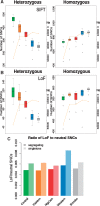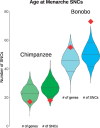Genetic Variation in Pan Species Is Shaped by Demographic History and Harbors Lineage-Specific Functions
- PMID: 30847478
- PMCID: PMC6482415
- DOI: 10.1093/gbe/evz047
Genetic Variation in Pan Species Is Shaped by Demographic History and Harbors Lineage-Specific Functions
Abstract
Chimpanzees (Pan troglodytes) and bonobos (Pan paniscus) are the closest living relatives of humans, but the two species show distinct behavioral and physiological differences, particularly regarding female reproduction. Despite their recent rapid decline, the demographic histories of the two species have been different during the past 1-2 Myr, likely having an impact on their genomic diversity. Here, we analyze the inferred functional consequences of genetic variation across 69 individuals, making use of the most complete data set of genomes in the Pan clade to date. We test to which extent the demographic history influences the efficacy of purifying selection in these species. We find that small historical effective population sizes (Ne) correlate not only with low levels of genetic diversity but also with a larger number of deleterious alleles in homozygosity and an increased proportion of deleterious changes at low frequencies. To investigate the putative genetic basis for phenotypic differences between chimpanzees and bonobos, we exploit the catalog of putatively deleterious protein-coding changes in each lineage. We show that bonobo-specific nonsynonymous changes are enriched in genes related to age at menarche in humans, suggesting that the prominent physiological differences in the female reproductive system between chimpanzees and bonobos might be explained, in part, by putatively adaptive changes on the bonobo lineage.
Keywords: bonobo genome; bonobo reproduction; comparative genomics; deleteriousness.
© The Author(s) 2019. Published by Oxford University Press on behalf of the Society for Molecular Biology and Evolution.
Figures




Similar articles
-
The Pan social brain: An evolutionary history of neurochemical receptor genes and their potential impact on sociocognitive differences.J Hum Evol. 2021 Mar;152:102949. doi: 10.1016/j.jhevol.2021.102949. Epub 2021 Feb 10. J Hum Evol. 2021. PMID: 33578304
-
Patterns of microsatellite polymorphism in the range-restricted bonobo (Pan paniscus): considerations for interspecific comparison with chimpanzees (P. troglodytes).Mol Ecol. 2000 Mar;9(3):315-28. doi: 10.1046/j.1365-294x.2000.00852.x. Mol Ecol. 2000. PMID: 10736029
-
High diversity at PRDM9 in chimpanzees and bonobos.PLoS One. 2012;7(7):e39064. doi: 10.1371/journal.pone.0039064. Epub 2012 Jul 2. PLoS One. 2012. PMID: 22768294 Free PMC article.
-
On the tool use behavior of the bonobo-chimpanzee last common ancestor, and the origins of hominine stone tool use.Am J Primatol. 2014 Oct;76(10):910-8. doi: 10.1002/ajp.22284. Epub 2014 Apr 7. Am J Primatol. 2014. PMID: 24710771 Review.
-
Reproductive inequality among males in the genus Pan.Philos Trans R Soc Lond B Biol Sci. 2023 Aug 14;378(1883):20220301. doi: 10.1098/rstb.2022.0301. Epub 2023 Jun 26. Philos Trans R Soc Lond B Biol Sci. 2023. PMID: 37381849 Free PMC article. Review.
Cited by
-
Does facial hair greying in chimpanzees provide a salient progressive cue of aging?PLoS One. 2020 Jul 14;15(7):e0235610. doi: 10.1371/journal.pone.0235610. eCollection 2020. PLoS One. 2020. PMID: 32663207 Free PMC article.
-
The impact of genetic adaptation on chimpanzee subspecies differentiation.PLoS Genet. 2019 Nov 25;15(11):e1008485. doi: 10.1371/journal.pgen.1008485. eCollection 2019 Nov. PLoS Genet. 2019. PMID: 31765391 Free PMC article.
-
Local genetic adaptation to habitat in wild chimpanzees.bioRxiv [Preprint]. 2024 Jul 9:2024.07.09.601734. doi: 10.1101/2024.07.09.601734. bioRxiv. 2024. PMID: 39026872 Free PMC article. Preprint.
-
Current Progress in Evolutionary Comparative Genomics of Great Apes.Front Genet. 2021 Aug 11;12:657468. doi: 10.3389/fgene.2021.657468. eCollection 2021. Front Genet. 2021. PMID: 34456962 Free PMC article. Review.
-
Regional TMPRSS2 V197M Allele Frequencies Are Correlated with COVID-19 Case Fatality Rates.Mol Cells. 2021 Sep 30;44(9):680-687. doi: 10.14348/molcells.2021.2249. Mol Cells. 2021. PMID: 34588322 Free PMC article.
References
-
- Behringer V, Deschner T, Deimel C, Stevens JMG, Hohmann G.. 2014. Age-related changes in urinary testosterone levels suggest differences in puberty onset and divergent life history strategies in bonobos and chimpanzees. Horm Behav. 66(3):525–533. - PubMed
-
- Brawand D, et al. 2011. The evolution of gene expression levels in mammalian organs [SupMat]. Nature 478(7369):343–348. - PubMed
Publication types
MeSH terms
Grants and funding
LinkOut - more resources
Full Text Sources
Miscellaneous

